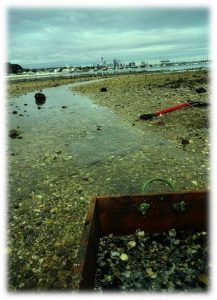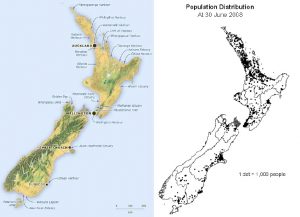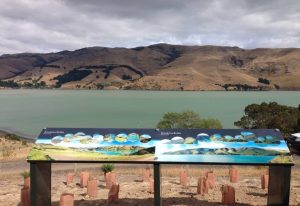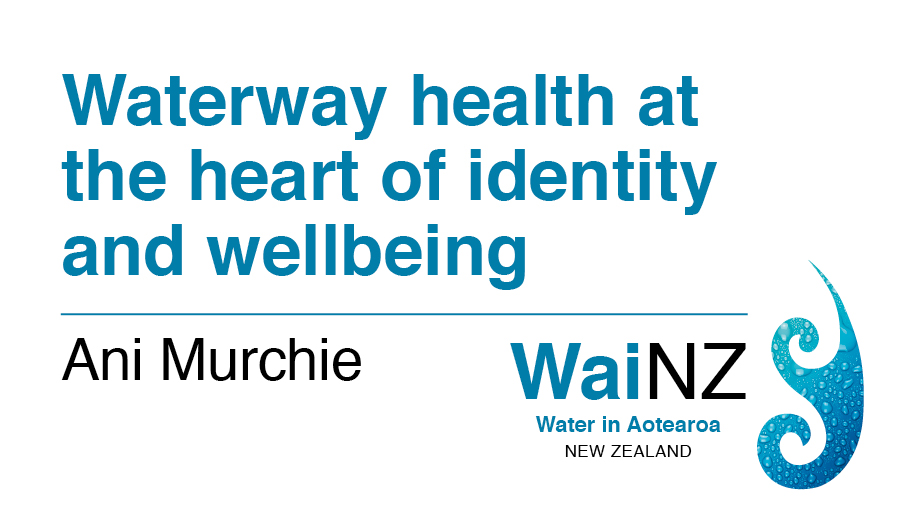Toitū a Tāne, toitū a Tangaroa, toitū te tangata
The endurance of man relies on that of the environment.
Waterway health is at the heart of identity and wellbeing. Signs restricting beach and river swimming or wading, and fish consumption, are becoming common sights across Aotearoa. So often missed, however, is how we may support existing kaitiaki and community groups to improve our environmental footprint.
Through my experience as a researcher in estuarine and coastal systems, the local hapū, iwi, and community residential groups are drivers of change. They hold long-term place-specific ecological knowledge and mātauranga Māori that benefits environmental management.

Image 1. Surveying shellfish beds at Ōkahu Bay, Tāmaki Makaurau, Auckland (photographed by Ani Kainamu Murchie).
In Aotearoa, we acknowledge our inextricable connectedness with our environment, from land-to-sea. Tangata whenua literally translates to ‘people of the land’, which beautifully captures the reciprocal relationship between people and their environment. Tangata whenua and non-Māori New Zealand residents identify with our riverine and coastal nation. They provide sustenance, leisure, amenities, identity and wellbeing.
Human land-uses and activities affect environmental health, and this subsequently affects socio-cultural and ecological values. Much like the environmental impacts across the globe, our national waterbodies have come under pressure due to anthropogenic impacts. Our water-bodies, in particular estuaries and harbours are major focal points of human settlement or high-intensity rural land-uses (see Image 2).

Image 2. The major estuaries (left) and population density in 2008 (right) in New Zealand. Images sourced from Te Ara and Statistics New Zealand.
The current management system in New Zealand does not treat freshwater and estuarine systems (including harbours) as integrated ecosystems; the latter is managed as coastal systems.
My research within Waitaha Canterbury and O`ahu Hawai`i was based on the Indigenous environmental approach ki uta ki tai and ma uka ma kai, by Ngāi Tahu and Kanaka Maoli respectively. Both literally mean ‘from inland-to-sea’; and ‘inland’ zone includes the mountain ranges. This approach captures the integrated nature of terrestrial, freshwater, estuaries and harbours. Ki uta ki tai, and ma uka ma kai, also includes people within this environmental principle practice.

Image 3. Koukourārata, also known as Port Levy, with catchment replanting from land-to-sea (photographed by Ani Kainamu Murchie).
Community cohesion within management is fundamental towards adaptive and sustainable solutions; and legal protection to these environments takes time and effort. Existing mātaitai reserves are the result of long-term commitment (sometimes 10+ years!) by local iwi and communities. The protection of these places benefits the socio-cultural and ecological values of estuaries and coasts in Aotearoa. Therefore, the sustainability of cultural-ecological systems (e.g. shellfish beds, wild-caught fish, fishpond culturing) rely on the commitment of local community efforts.
Although, current management protocols protect us from human health hazards, by closing sites from either harvesting shellfish or swimming or both; this also disconnects people with place. Consequently, this erodes long-term ecological knowledge, mātauranga, and the application of these within local management. Rather, local and indigenous people’s ecological indices are vital towards more adaptive management.
In conclusion, iwi, hapū, and local resident communities are committed to caring, stewarding, and protecting the health of their local environment. There are a number of ways we as individuals, researchers, and government bodies can assist with local iwi and community kaitiakitanga, which ultimately provides for our wellbeing.
Toitū a Tāne, toitū a Tangaroa, toitū te tangata.
nā Ani Kainamu Murchie
About:
Ko Ani Kainamu Murchie tōku ingoa, he uri ahau nō Ngāpuhi, Ngāti Kahu ki Whangaroa, me Kōtirana. I have a background in both te Ao Māori and te Ao Pākehā, through attending kōhanga reo, kura Māori, Māori and Marine studies at tertiary level, with national and global education and experiences. Like many New Zealanders my whānau are very fond of spending time near and on the water, from leisurely strolls, harvesting, to paddling waka ama. I am passionate about our connection to the environment, and particularly at the local iwi and community levels. My graduate research has focused on shellfish ecological and sociocultural values to better inform management. I have recently completed my PhD in Environmental Sciences at the Ngāi Tahu Research Centre and School of Biology of the University of Canterbury. I am also an Alumni of the Fulbright Science and Innovation Award (2013) and First Nations Futures Programme Alumni at Stanford University.
What is WaiNZ?
Kia ora, Aotearoa. We’ve asked leading environmental, social and health researchers to share their personal and professional perspectives about the state of our water and what water means to us as New Zealanders. Follow their blogs right here at tepunhahamatatini.ac.nz and across social media with #WaiNZ.
Where possible, commentary will be backed up by data from Figure.NZ. Their incredible charts are based on data sourced from public repositories, government departments, academics and corporations. Check out their #WaiNZ data board and sign-up to create your very own data board on any topic that interests you.

